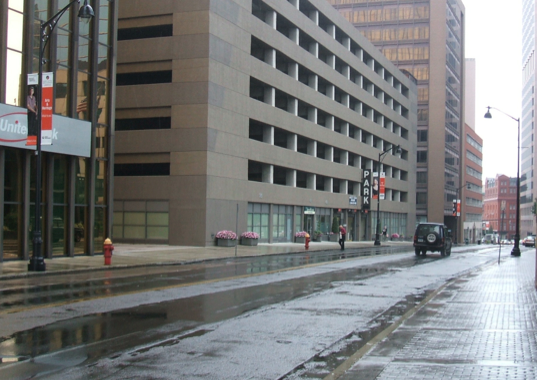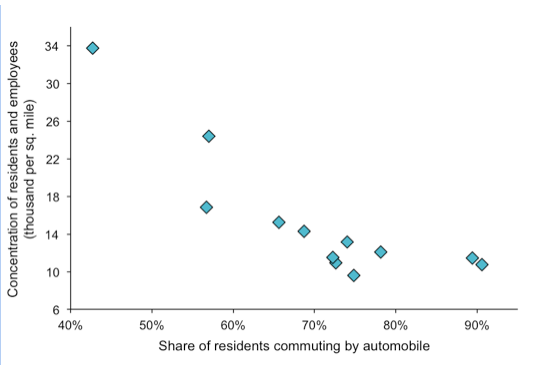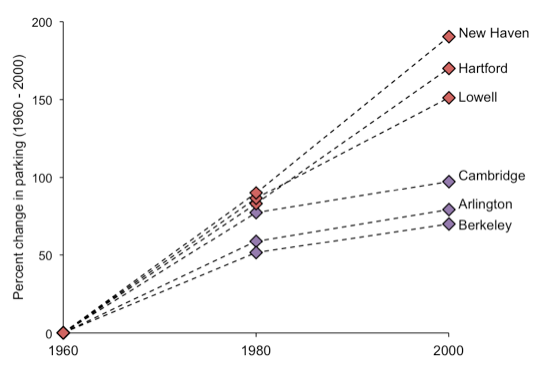50 years ago, experts predicted automobiles would drain the life from urban areas. Their predictions are coming true.
Big roads and parking garages are so common in American cities that it’s easy to forget these places once functioned exceptionally well without them. However, in their persistent battle to satisfy the demands of motorists, many urban areas are losing out.
In the early 1960s – when highway construction was at its peak and cars were just beginning to leave their mark – a handful of critics predicted there would be irreconcilable tensions between vibrant cities and their motorized inhabitants. Nearly 50 years later, researchers at the University of Pennsylvania published research validating this idea.
Their conceptual model was based on a straightforward premise: cars take up a lot of space, especially when it comes to storing them all day while their owners work. In dense cities where land is scarce, according to the model, more cars meant there would be fewer people, unless those people could be stacked in taller buildings with smaller footprints.
From our partners:
For many cities, this seems to be what happened. Cities were gutted to make room for cars and buildings got taller. But what happened to the people? A research team at the University of Connecticut set out to answer this question.
For the study, recently published in Urban Design International, the team analysed a dozen historically dense, small cities from around the country in which the shares of residents getting to work by automobile range from 43 to 91 percent. They compared the rates of automobile use to the number residents and employees per square mile.
They found that cities with higher rates of driving have fewer people – a difference of more than 4,000 people per square mile for each 10 percent change in automobile use. As the Penn model suggests, this has to do with the amount of land used to move and store all those cars.
As it turns out, the amount of land used for parking is a key indicator of how seriously automobile infrastructure has impacted an urban environment. The researchers were able to determine the amount of off-street parking in each of the cities by looking at aerial photographs. What they found was shocking. In cities with higher rates of automobile use (roughly 30 percent more driving), about twice as much land is committed to parking for each resident and employee.

Part of the reason for these huge differences in automobile use and infrastructure among the cities can be explained by considering how they have changed over the past fifty years. The researchers mapped changes in parking supplies since 1960 for six of the cities in their study. As expected, all of the cities bolstered their parking considerably. The city leaders played an important role, either by requiring developers to include parking or by having it built themselves. Municipal records reveal they did this in hopes that it would support economic development and help their cities compete with the surrounding suburbs.
However, this philosophy changed in some of the cities after 1980. In Cambridge, Massachusetts, for example, officials adopted parking limits in the zoning code – parking limits that are lower than the minimum parking requirements in some cities today. Of the six cities they looked at, parking supplies in three cities just about leveled off after 1980. In the other three, parking supplies nearly doubled for a second time.
If the function of parking in these places was to enable growth and development, the data suggests they were abysmal failures. The number of people and jobs dropped by as much as 15 percent and the median family incomes fell by 20 to 30 percent in some places. Today, these places still struggle to compete in their regions.
What actually increased in these cities were the rates of driving. Driving increased for people commuting in and out of the city by more than 30 percent. But even for shorter trips within each city, driving increased by as much as 45 percent. Even worse, this change was the most pronounced in places where vehicle ownership rates remained the lowest (low-income cities). The combined effects of improved convenience for drivers, a degraded walking environment, service cuts to public transit and the physical separation of residential and commercial areas were forcing city-dwellers into cars.
Cities like Berkeley, Arlington and Cambridge experienced something different. Even as they cut back on surface parking, the number of people and jobs climbed upward, as did incomes. Less parking in these places has meant the urban fabric can be stitched back together and there is more space for shops, restaurants, jobs and other things that make cities great. More importantly, the parking isn’t needed. People own cars at higher rates, but they don’t use them as much. Instead, they live close to the urban core where upwards of 30 percent walk or bike to work.
Today, in many cities, roads and parking facilities continue to grow, as though the problem for the last 50 years has been that the growth was not enough. These cities might be able to guarantee a parking space in front of every destination that still remains (or they might not), but they are likely doing so at the expense of those things that cities really need – namely, people.
This article originally appeared in CityLab.




















